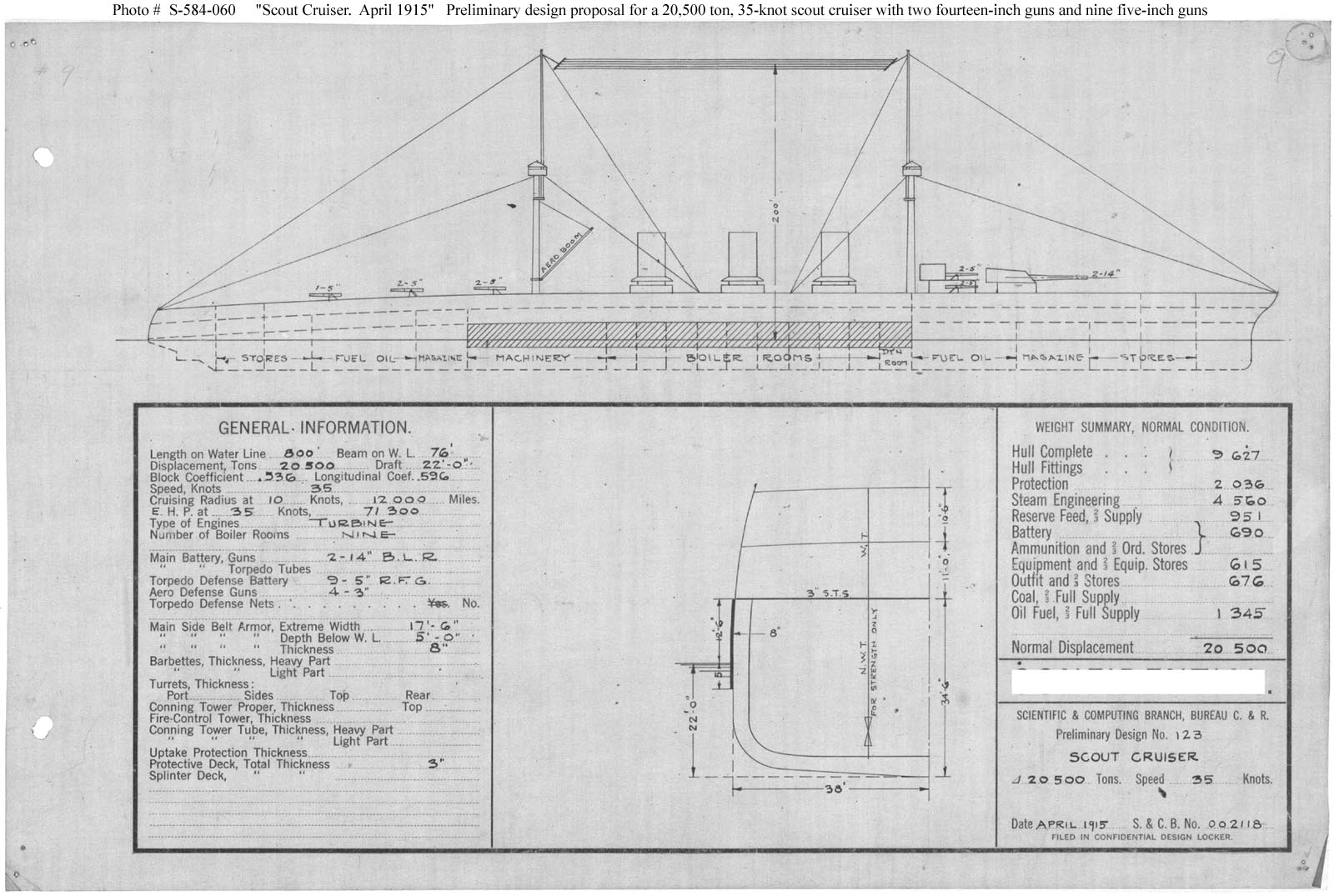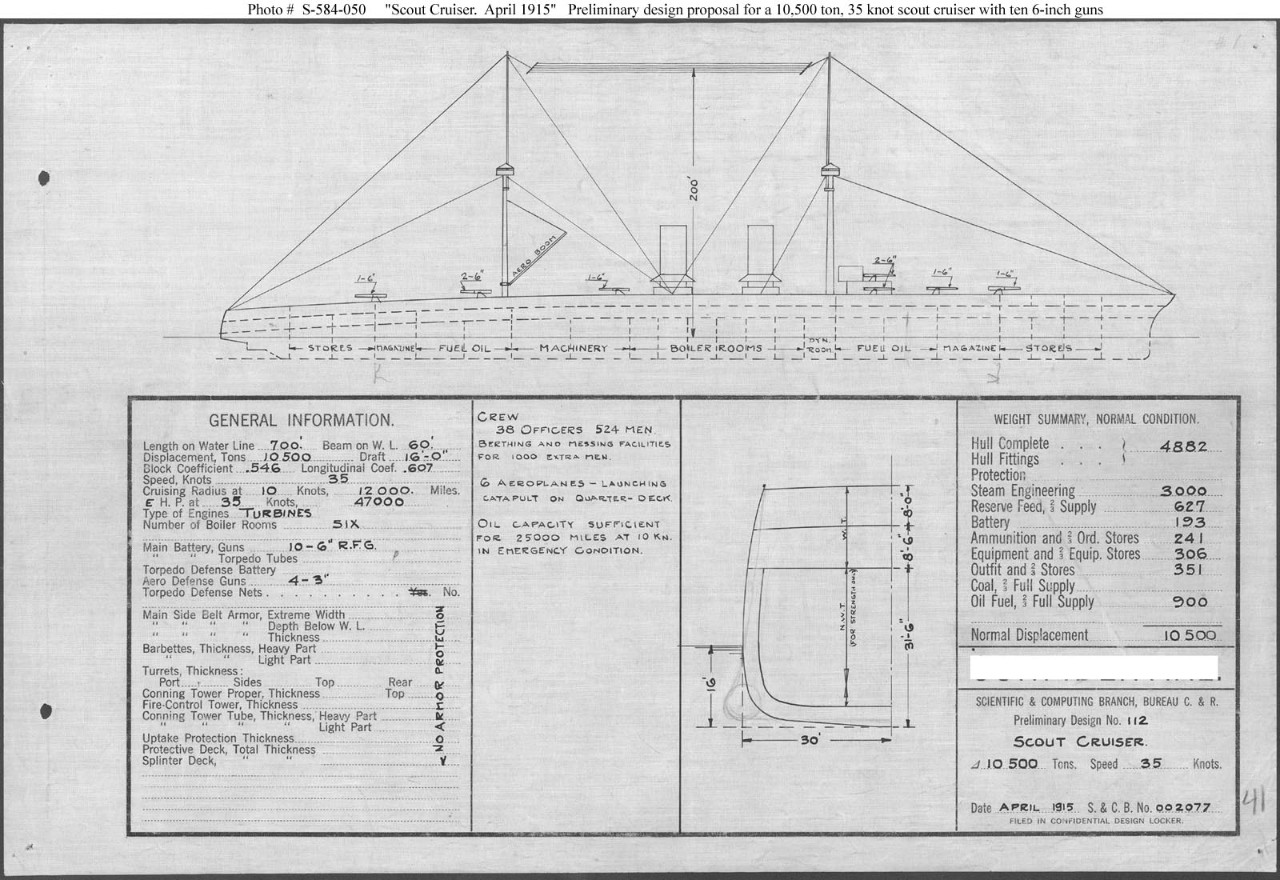lordroel
Administrator
Posts: 67,964 
Likes: 49,365
|
Post by lordroel on Apr 26, 2022 19:02:29 GMT
So who know more about this design: Image enlarged:  |
|
stevep
Fleet admiral
Posts: 24,832 
Likes: 13,222
|
Post by stevep on Apr 26, 2022 22:03:29 GMT
So who know more about this design: Image enlarged: 
Don't know but wonder if this is the origins of the 1916 Lexington design? Speed is the same as well as the use of 14" guns but of course the latter was ~10,000 tons more with 10x14" and the seven funnels and other oddities to get that speed.
|
|
lordroel
Administrator
Posts: 67,964 
Likes: 49,365
|
Post by lordroel on Apr 27, 2022 13:08:50 GMT
So who know more about this design: Image enlarged:  Don't know but wonder if this is the origins of the 1916 Lexington design? Speed is the same as well as the use of 14" guns but of course the latter was ~10,000 tons more with 10x14" and the seven funnels and other oddities to get that speed.
Think not, stevep , the designs look different, also the design i posted is a scout cruiser design, the image i posted here is of a battlecruiser.  |
|
stevep
Fleet admiral
Posts: 24,832 
Likes: 13,222
|
Post by stevep on Apr 27, 2022 17:28:24 GMT
Don't know but wonder if this is the origins of the 1916 Lexington design? Speed is the same as well as the use of 14" guns but of course the latter was ~10,000 tons more with 10x14" and the seven funnels and other oddities to get that speed.
Think not, stevep , the designs look different, also the design i posted is a scout cruiser design, the image i posted here is of a battlecruiser. 
Possibly but the use of 14" guns on a very fast lightly armoured ship designed for fleet scouting are all there. That was the basis for my comparison.
|
|
lordroel
Administrator
Posts: 67,964 
Likes: 49,365
|
Post by lordroel on Apr 27, 2022 17:37:10 GMT
Think not, stevep , the designs look different, also the design i posted is a scout cruiser design, the image i posted here is of a battlecruiser.  Possibly but the use of 14" guns on a very fast lightly armoured ship designed for fleet scouting are all there. That was the basis for my comparison.
Also the Lexington-class battlecruiser is almost twice as heavy (43,500 ton) then the Scout Cruiser 1915 design (25,000 tons). Did find a description over at Naval History and Heritage Command - S-584-057 Preliminary Design No.119 for a Scout Cruiser ... April 1915Preliminary Design No.119 for a Scout Cruiser ... April 1915 Preliminary design plan for a large scout cruiser, prepared to support General Board discussions concerning the characteristics sought in future cruisers. This plan provided four 12-inch guns and seven 5-inch guns and a speed of 35 knots in a ship 755 feet long on the load water line, 74 feet in beam, with a normal displacement of 18,200 tons. This design included 1,005 tons of armor, 4-inch side armor over 322 feet by 17 feet 6 inches amidships plus 1.5-inch deck protection, adding 7,700 tons displacement over design No.112. This design was fourth in a set of 11 undertaken as a group to explore tradeoffs among armament, protection, and size in large scout cruisers capable of 35 knots speed. This design series took Preliminary Design No.112 ( see Photo # S-584-050) as a baseline. Ultimately, however, no ships of this type were built. |
|
1bigrich
Sub-lieutenant
Posts: 478
Likes: 611
|
Post by 1bigrich on Apr 28, 2022 14:01:47 GMT
So who know more about this design: Image enlarged:  This design series was really as much of a dead-end as the Armored Cruiser. The idea of four heavy guns, 12in, 14in or 16in, with a light secondary battery and very light armor to get very high speed had little chance of being built in my opinion, and less of a chance of being able to accomplish a scouting mission. With only four main battery guns, though large, there are not enough barrels to accomplish effective salvo firing. So in performing the scouting function, they have little chance of effectively engaging enemy screening units at range. If they are in range where their light secondary batteries can come into play, most don't have the armor to stay in battle for very long. It's little wonder they were succeeded by battlecruisers concepts on the heavy guns. What was probably needed, with the technology of the time, was one of the April 1915 concepts that had a 6in main battery, though some of those were as large as 15,000 tons. The Omaha class descend form these in a way, but with technological progress accomplish it on far less tonnage. Further, the USN had the experience of the Pennsylvania- and Tennessee-class (the Big 10) armored cruisers. And they showed that move up to a 10in main battery for the Tennessees was to big, and the 8in was a better cruiser gun. These heavy-gun scout concepts would have repeated that same lesson. One of the reasons we got the 8in cruiser gun limit in the Washington Treaty was this experience; the USN was looking forward with 8in gunned cruisers Thankfully none of these heavy-gun scout cruiser concepts were laid down, and real battlecruisers were instead. Had they been built, they would likely have been found wanting as the Royal Navy's Large Light Cruisers were, and the best that could be hoped for for use out of the hulls would have been conversions to aircraft carriers, and even then the true battlecruisers were more useful as carrier conversions than any of these concepts would have been. My thoughts, |
|
lordroel
Administrator
Posts: 67,964 
Likes: 49,365
|
Post by lordroel on Apr 28, 2022 14:11:52 GMT
So who know more about this design: Image enlarged:  This design series was really as much of a dead-end as the Armored Cruiser. The idea of four heavy guns, 12in, 14in or 16in, with a light secondary battery and very light armor to get very high speed had little chance of being built in my opinion, and less of a chance of being able to accomplish a scouting mission. With only four main battery guns, though large, there are not enough barrels to accomplish effective salvo firing. So in performing the scouting function, they have little chance of effectively engaging enemy screening units at range. If they are in range where their light secondary batteries can come into play, most don't have the armor to stay in battle for very long. It's little wonder they were succeeded by battlecruisers concepts on the heavy guns. What was probably needed, with the technology of the time, was one of the April 1915 concepts that had a 6in main battery, though some of those were as large as 15,000 tons. The Omaha class descend form these in a way, but with technological progress accomplish it on far less tonnage. Further, the USN had the experience of the Pennsylvania- and Tennessee-class (the Big 10) armored cruisers. And they showed that move up to a 10in main battery for the Tennessees was to big, and the 8in was a better cruiser gun. These heavy-gun scout concepts would have repeated that same lesson. One of the reasons we got the 8in cruiser gun limit in the Washington Treaty was this experience; the USN was looking forward with 8in gunned cruisers Thankfully none of these heavy-gun scout cruiser concepts were laid down, and real battlecruisers were instead. Had they been built, they would likely have been found wanting as the Royal Navy's Large Light Cruisers were, and the best that could be hoped for for use out of the hulls would have been conversions to aircraft carriers, and even then the true battlecruisers were more useful as carrier conversions than any of these concepts would have been. My thoughts, Seems the first one i posted was of a set of three, here are the two others i manged to find, i think Number II Number III Number III |
|









